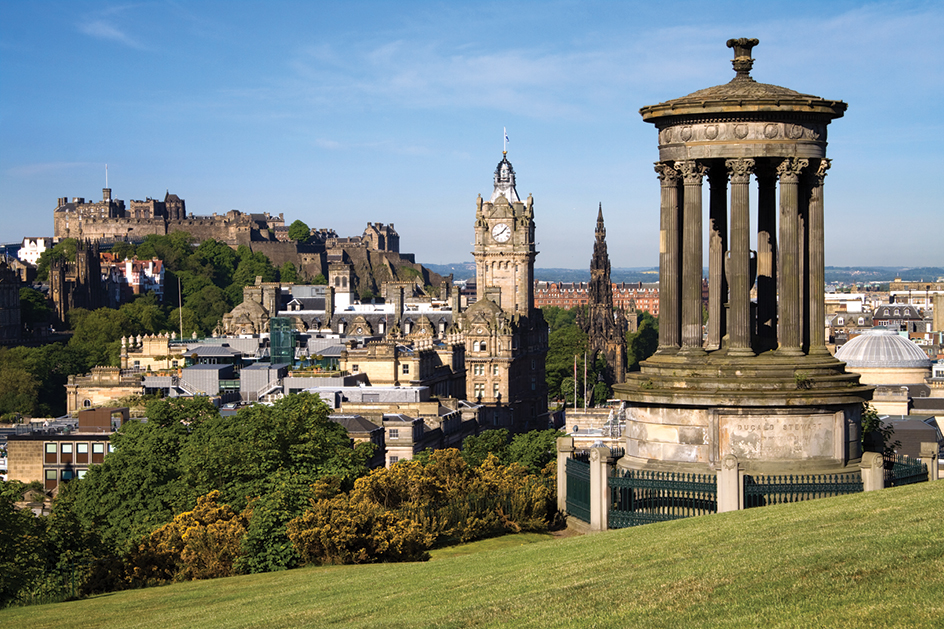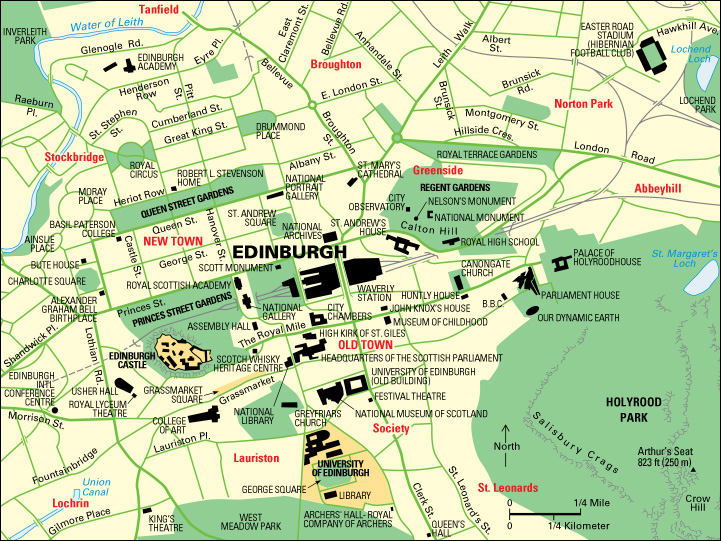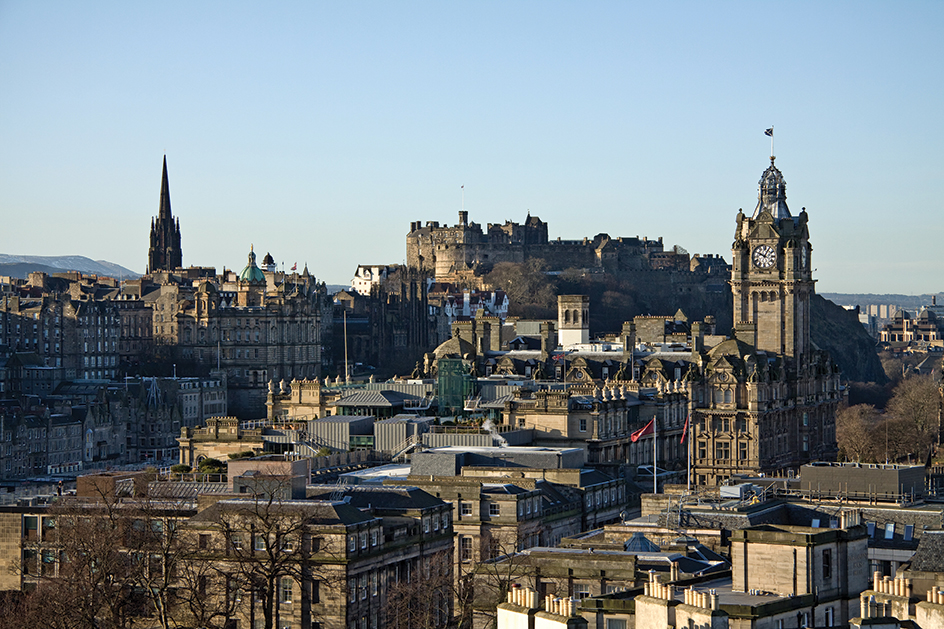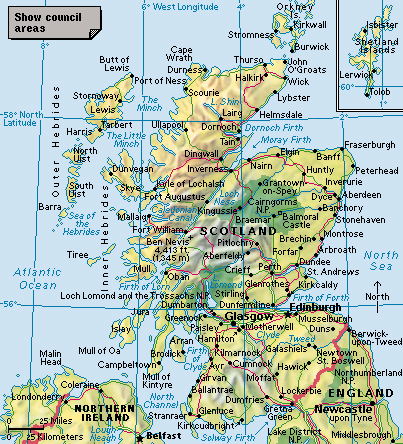Edinburgh, << EH duhn buh ruh, >> is the capital and second largest city of Scotland. Only Glasgow is larger. Edinburgh stands on hills south of the Firth of Forth, the mouth of the River Forth, which flows into the North Sea on the east coast of Scotland.

Edinburgh is home to many Scottish institutions. The Scottish Parliament and many other agencies of the Scottish government are based there. The Order of the Thistle, a Scottish order of knighthood, has a tiny chapel in Edinburgh’s principal church, the High Kirk of St. Giles, also known as St. Giles’s Cathedral. The Royal Company of Archers, which serves as the British monarch’s bodyguard in Scotland, is based in Edinburgh.
Many leading Scottish authors lived in Edinburgh. They include Robert Burns, the national poet of Scotland, who wrote during the late 1700’s; and Sir Walter Scott and Robert Louis Stevenson, who wrote during the 1800’s. Another famous resident of Edinburgh was the religious reformer John Knox, who led the Scots in establishing a Protestant national church in the 1560’s.
The city
The central city.
The center of Edinburgh is divided into the Old Town and the New Town. The Old Town is a tangle of winding medieval streets and narrow passageways called wynds and closes. Landmarks in Old Town include Edinburgh Castle, the High Kirk of St. Giles, the Palace of Holyroodhouse, John Knox’s house, the Scottish Parliament Building, and the University of Edinburgh.


The New Town, built during the 1700’s and early 1800’s, has wide streets laid out in a symmetrical pattern. At the center of the New Town lies an open space called St. Andrew’s Square. It ranks as one of the richest squares in Europe because of the many banks and financial institutions that have their headquarters there.
Edinburgh’s main thoroughfare, Princes Street, lies at the south edge of New Town. Princes Street ranks as one of the world’s most beautiful thoroughfares, lined with fashionable stores, hotels, art galleries, and historic buildings. Railroad trains pass through a ravine along the south side of Princes Street. Also on the south side of the street are the Princes Street Gardens, famous for their flower clock, a clock-shaped flower bed planted with low-growing plants. Among the gardens’ many statues and monuments, the largest is the Scott Monument. The 200-foot (61-meter) gothic tower honors a famous son of Edinburgh, writer Sir Walter Scott.
Edinburgh stands on a number of hills, the remnants of ancient volcanoes. Across the Princes Street ravine is Castle Rock, an extinct volcano with Edinburgh Castle on top. Calton Hill rises 330 feet (100 meters) above the east end of Princes Street overlooking the New Town. A number of historic buildings and monuments stand on Calton Hill, including Nelson’s Monument, dedicated to the British naval hero Admiral Horatio Nelson, and the Royal High School, founded in the 1500’s.

An even larger extinct volcano called Arthur’s Seat dominates the Edinburgh skyline, towering 823 feet (250 meters) above the city. Arthur’s Seat and a series of hills called the Salisbury Crags form part of a large public park called Holyrood Park.
The Royal Observatory stands on Blackford Hill, in a public park on the city’s south side.
West of Edinburgh Castle is the city’s new financial center, called the Exchange. The City of Edinburgh developed a plan to create the Exchange in the late 1980’s. The area includes the Edinburgh International Conference Centre and the headquarters of some of Scotland’s largest financial companies, among them Clydesdale Bank; Scottish Widows, an investment company; and Standard Life, an insurance company.
Outlying areas.
Leith and Portobello lie north of the city, on the Firth of Forth. Both were once separate towns, but Portobello merged with Edinburgh in 1896 and Leith did so in 1920. Portobello has a fine sandy beach. Leith is Edinburgh’s port and a service center for the North Sea oil industry. Edinburgh is redeveloping part of the waterfront and former industrial areas in Leith and in the nearby port of Granton as a business, entertainment, residential, and shopping district. To the south is the suburb of Sciennes, which has prosperous villas and terraces dating from the Victorian period, the middle and late 1800’s.
West of the city, near Edinburgh Airport, is an area called Edinburgh Park. It is a business park, an area designed to attract businesses. Corstorphine Hill is a long, low wooded ridge that rises above some of the western suburbs, including Balgreen, Blackhall, Corstorphine, and Murrayfield.
People
Ancestry.
Most of the people of Edinburgh are of Scottish ancestry. The largest number of non-Scottish inhabitants are people who have moved to Edinburgh from other parts of the United Kingdom, especially England. Since the mid-1900’s, many people from China, India, and Pakistan have settled in Edinburgh.
Religion.
The Church of Scotland, a Presbyterian church, is the official church of Scotland. It has its headquarters in Edinburgh. The General Assembly of the Church of Scotland, a gathering of ministers and officers of the church, meets once a year at the Assembly Hall in Edinburgh to discuss Scottish and world affairs as well as church matters.
Housing.
Small homes, apartment buildings, and row houses, series of single-family homes that share a common wall with the house next door, are the most common forms of housing in Edinburgh.
Education.
Edinburgh has been a seat of learning since the 1500’s. Edinburgh University, founded in 1583, is famous for its faculties of divinity, law, and medicine. Heriot-Watt University, in the southwestern suburb of Riccarton, emphasizes science, technology, and engineering. Napier University has several campuses south and west of the city. There are several colleges of higher and specialist education, including Basil Paterson Edinburgh, Edinburgh College of Art, the Scottish Agricultural College, Stevenson College, and Telford College.
Economy
Manufacturing.
Edinburgh has many different industries. Printing and publishing are well established, and there is a tradition of making biscuits (cookies). The distilling of whisky and the brewing of beer are traditional industries. The city’s largest breweries include Caledonian Brewery and Scottish & Newcastle. Edinburgh has numerous computer and computer-related industries. It lies at the eastern end of Silicon Glen, an area of Scotland known for its large numbers of high-technology companies. Other important industries include medical technology and the production of pharmaceuticals.
Service industries.
As the capital of Scotland, Edinburgh is the headquarters of many departments of the Scottish government. Thousands of civil servants work in government offices in the city.
Trade.
The port of Leith has facilities for handling bulk dry goods, such as coal and barley, for export. It imports grain and fertilizer. The port also has facilities for container ships and roll-on/roll-off ships, which carry wheeled cargo, such as railroad cars and truck trailers.
Finance and business.
Edinburgh is Scotland’s main center for finance, banking, insurance, and investment. The Bank of Scotland was founded in Edinburgh in 1695 by an act of the Scottish Parliament. The bank is now part of the HBOS Group, which has its headquarters in Edinburgh. The Royal Bank of Scotland, founded in 1747 by royal charter, is one of Europe’s largest banks. The Royal Bank has headquarters in the western suburb of Gogarburn.
Tourism
in Edinburgh makes a major contribution to the economy, attracting millions of visitors a year. The city ranks as Scotland’s most popular tourist destination in terms of number of visitors, and the second most popular in the United Kingdom after London.
Transportation.
Edinburgh Airport connects travelers to many cities within the United Kingdom, as well as cities in Europe and North America. A tram system connecting the airport to the city center opened in 2014. Edinburgh has two train stations near the city center, Waverley Station and Haymarket Station. Bus services carry passengers between the city and suburbs, and provide links with most major towns throughout Scotland.
Communication.
The city has a number of print and electronic newspapers and magazines. Both the British Broadcasting Corporation (BBC) and STV (formerly Scottish Television) have studios in Edinburgh. The city receives national radio broadcasts and has several local stations.
Cultural life and recreation
Music and theater.
The musical life of the city is lively. The Scottish Ballet and Scottish Opera perform at the Edinburgh Festival Theatre. The Playhouse Theatre hosts many musical events, including pop concerts. The Scottish Chamber Orchestra plays at Queen’s Hall. The Royal Scottish National Orchestra, based in Glasgow, gives weekly concerts in winter in Edinburgh’s Usher Hall. The two principal theaters are the King’s Theatre and the Royal Lyceum Theatre, which has a resident company.
Sports and recreation.
Edinburgh has two professional soccer teams, the Heart of Midlothian Football Club and the Hibernian Club, known locally as the Hearts and the Hibs. Both teams play in the Bank of Scotland Scottish Premier League, Scotland’s highest soccer league. Rugby is also popular. The National Rugby Team of Scotland is based in Edinburgh and plays international matches at Murrayfield.
Golf has been played in Edinburgh since 1457, and the city and surrounding area have many golf courses. The Braid Hills are famous for their challenging course.
Holyrood Park, Edinburgh’s largest park, lies next to the Palace of Holyroodhouse. Picnickers and hikers enjoy the park’s wide meadows, lochs (lakes), and fine views of the city from the top of Arthur’s Seat and the Salisbury Crags. Corstorphine Hill is another large public park, with the Edinburgh Zoo on the northern slopes of the hill. Visitors also enjoy strolling through the Royal Botanic Garden, just north of the city center.
Hikers enjoy walking on Edinburgh’s many hills. The Pentland Hills, a range that begins on the southern outskirts of the city, attracts many walkers.
Festivals.
Edinburgh bustles each August and September during the Edinburgh International Festival. Founded in 1947, the festival features opera companies, symphony orchestras, dance companies, theater companies, and chamber groups from Scotland and around the world. An offshoot of the festival, the Festival Fringe, is a hugely popular event. Thousands of artists perform at the Fringe in small theaters and on the streets of the city. Another popular attraction is the Edinburgh Military Tattoo, held in the courtyard of Edinburgh Castle.
Edinburgh is famous for Hogmanay, a four-day festival celebrating New Year’s Eve. The festivities include street parties, parades, and fireworks. Edinburgh has a number of other festivals throughout the year.
The arts
Architecture.
Edinburgh’s New Town ranks as one of the best examples of Georgian architecture in the United Kingdom. Georgian architecture, the chief building style in England and Scotland during the 1700’s and early 1800’s, emphasized simplicity, symmetry, and classical details. A landmark in New Town is Charlotte Square, a graceful open space surrounded by buildings designed by the Scottish architect Robert Adam in 1791. One of the buildings on the square is Bute House, which has served since 1999 as the official residence of the first minister of Scotland, the head of the Scottish government.
Edinburgh also has fine modern architecture. The British architect Sir Terry Farrell designed much of the Exchange financial district, including the Edinburgh International Conference Centre (1995), a huge circular stone building. The headquarters of the Scottish Parliament, designed by the Spanish architect Enric Miralles, stands near the Palace of Holyroodhouse. The Parliament building opened in 2004.
Libraries
include the National Library of Scotland, Scotland’s largest library and a center for the study of Scottish history and culture. The University of Edinburgh Library has the largest collection of any university library in Scotland. Edinburgh City Libraries operates a system of public libraries with branches throughout the city.
The Signet Library, a law library, occupies a building that dates from 1822 and was designed by the Scottish architect Robert Reid. Another law library, the Advocates’ Library, is in Parliament House in the Old Town. The Scottish philosopher David Hume was once librarian at the Advocates Library, which was founded in 1682.
Art museums.
The National Gallery of Scotland stands in the center of the Princes Street Gardens. It has European paintings dating from the 1300’s through the 1800’s, including works by the Flemish painter Peter Paul Rubens and the French painters Paul Cézanne and Paul Gauguin. The Scottish National Portrait Gallery has portraits of such famous Scots as Mary Queen of Scots and Robert Burns. The Scottish National Gallery of Modern Art has pictures and sculptures by artists of the 1900’s.
Other museums.
The National Museum of Scotland has galleries devoted to Scottish history, world cultures, and science and technology. The Scotch Whisky Heritage Centre explains in detail the creation and history of the famous local beverage. The Writers’ Museum, in a mansion dating from the 1600’s, is dedicated to Burns, Scott, and Stevenson. The People’s Story Museum has exhibits describing daily life in Edinburgh from the 1700’s through the 1900’s. The Royal Scottish Academy changes exhibits frequently. The academy is housed in a magnificent building in Princes Street, built as the Royal Institution in 1823. The National War Museum of Scotland, in Edinburgh Castle, has exhibits on Scottish military history. The Museum of Childhood displays old toys, schoolbooks, and other items used by children.
Visitor’s guide
Castles and palaces.
Edinburgh Castle stands on Castle Rock, a huge rock overlooking the city. Within the castle walls is the city’s oldest building, the Chapel of St. Margaret, probably built in the 1000’s. On display in the Crown Room at the castle are Scotland’s crown jewels, a jeweled crown, sword, and scepter used by the kings and queens of Scotland. The castle also has the famous Stone of Scone, which has been part of the coronation chair used by British monarchs for more than 1,000 years.
A cobblestone road called the Royal Mile leads from the castle to the Palace of Holyroodhouse. The Royal Mile has four different street names along its length: Castlehill, Lawnmarket, High Street, and Canongate. Along the Royal Mile stand historic houses and the High Kirk of St. Giles. The Heart of Midlothian is a heart-shaped design in the cobblestones of the Royal Mile near the High Kirk. The design marks the site where a hated prison called the Tolbooth stood from the 1500’s until it was torn down in 1817.
The Palace of Holyroodhouse, which dates from the 1670’s, is used by the British royal family on visits to Scotland. Visitors can tour the palace when the royal family is not staying there. See Holyroodhouse, Palace of .
Churches.
The ancient High Kirk of St. Giles was a Roman Catholic church until the Protestant Reformation came to Scotland in 1560. In 1633, it became an Anglican cathedral, and it is now a Presbyterian church. Four pillars inside the church date from the 1120’s, and other parts of the church were built from the 1300’s through the 1500’s. The Thistle Chapel inside the church has beautiful stained-glass windows.
A landmark in Old Town is Greyfriars Kirk, which dates from 1612. There, according to legend, a Skye terrier named Greyfriars Bobby guarded his master’s grave for 14 years after the man died in 1858.
Many visitors come to Rosslyn Chapel, in the village of Roslin about 6 miles (10 kilometers) south of Edinburgh. The beautiful stone chapel, which dates from the 1400’s, is carved from floor to ceiling with biblical scenes, animals, plants, and people.
Other places of interest.
In the Old Town is John Knox’s House, the home of the Scottish religious reformer. The house dates from the 1500’s and is one of the oldest houses in the city. The Scottish National War Memorial, in Edinburgh Castle, is a monument to Scotland’s war dead.
Parliament House in Old Town dates partly from 1639. The building no longer houses the Scottish Parliament. Instead, it serves as the center of the Scottish legal system, housing the Court of Session, the Court of Criminal Appeal, and other legal institutions. Opposite Parliament House stand the City Chambers, now the headquarters of the City of Edinburgh Council. The chambers were built in 1753 as the Royal Exchange, where merchants and lawyers could carry out business.
Many visitors tour the royal yacht Britannia, formerly used by the royal family of the United Kingdom. The yacht was taken out of service in 1997 and now lies at anchor in the port of Leith.
Government
The City of Edinburgh Council consists of 58 elected councilors. Each of the city’s 17 wards has either three or four councilors. The council has responsibility for parks, trash collection, local education, museums and libraries, and other city services. The council elects a leader called the lord provost. The city of Edinburgh is a unitary authority, an area of Scotland with all local government powers within its borders.
History
People probably lived in the region of Edinburgh by about 1500 B.C. By the A.D. 500’s, the area was the site of a fort built by the local Celtic-speaking tribe, which was known as the Gododdin or the Votadini. The Gododdin called the stronghold Din Eidyn, sometimes spelled Dineidin, a Celtic name meaning fortress on a hill. A Welsh poem composed about 600, Y Gododdin, mentions Din Eidyn and describes warriors feasting there “in Eidyn’s great hall.”
In 638, the Anglo-Saxon kingdom of Northumbria conquered southeastern Scotland, including Din Eidyn. The Northumbrians changed the settlement’s name in their own language to Edinburgh.
By the 900’s, the Gaelic-speaking Scots controlled a large kingdom north of the Firth of Forth. In the late 900’s to early 1000’s, they conquered most of the southern Scotland, including Edinburgh.
The town became a royal stronghold. Its earliest city charter has been lost, but other documents issued by David I, the Scottish king from 1124 to 1153, suggest that David probably made Edinburgh a royal burgh in about 1124. A burgh (pronounced bur ruh) was a unit of local government, usually a town, with trading rights and some powers of self-government. An official called a provost, similar to a lord mayor, headed each royal burgh. Status as a royal burgh now has only ceremonial value.
David also founded Holyrood Abbey in about 1128 and granted it lands in what is now central Edinburgh. A royal charter issued in 1329 gave Edinburgh increased trading privileges, including control of the port of Leith. Gradually, Edinburgh became the main residence of the Scottish kings. By the mid-1400’s, Edinburgh had become the capital of Scotland.
In the 1500’s, Edinburgh became the center of the Reformation and the home of the Reformation leader John Knox. In 1560, the Treaty of Edinburgh ended a civil war in Scotland between Scottish Protestants and Scottish Roman Catholics backed by France. See Edinburgh, Treaty of .
Edinburgh declined as a center of government after the Act of Union in 1707, which joined Scotland with England and Wales as a “united kingdom of Great Britain,” later known as the United Kingdom. The Scots dissolved their Parliament and sent representatives to the British Parliament. But Edinburgh continued to expand as a cultural and commercial center. It became an important center of the intellectual movement called the Enlightenment, led by the University of Edinburgh and by such thinkers as the economist Adam Smith and the philosopher David Hume. The first Scottish daily newspaper, The Conservative, was published in Edinburgh in 1737.
During the 1800’s, Edinburgh became a center of literary activity. Such famous writers as Robert Louis Stevenson and Sir Walter Scott lived in the city. Edinburgh publishers produced Blackwood’s Edinburgh Magazine (later called Blackwood’s Magazine), Chambers’s Edinburgh Journal, and the Edinburgh Review, three of the most influential British magazines of the 1800’s. The brothers William and Robert Chambers founded the publishing company W. & R. Chambers, Ltd. in Edinburgh in 1832. Besides the Edinburgh Journal, their best-known publications included Chambers’s Encyclopaedia, 10 volumes published from 1859 to 1868, and a two-volume almanac called The Book of Days (1862-1864).
In the 1920’s and 1930’s, Edinburgh became the center of a literary movement called the Scottish Renaissance. Hugh MacDiarmid and other writers of the Renaissance wanted to create a Scottish national literature and preserve regional dialects. The Edinburgh International Festival was established in 1947 and soon began to draw thousands of visitors to the city.
During the 1970’s, the development of North Sea oil stimulated much new industry in Edinburgh. The city hosted the Commonwealth Games, an amateur sports competition for the Commonwealth of Nations, in 1970 and again in 1986.
In 1999, the United Kingdom granted Scotland its own government, transferring many powers from the government in London to the new government in Edinburgh. The Scottish Parliament began to meet in Edinburgh that year.
